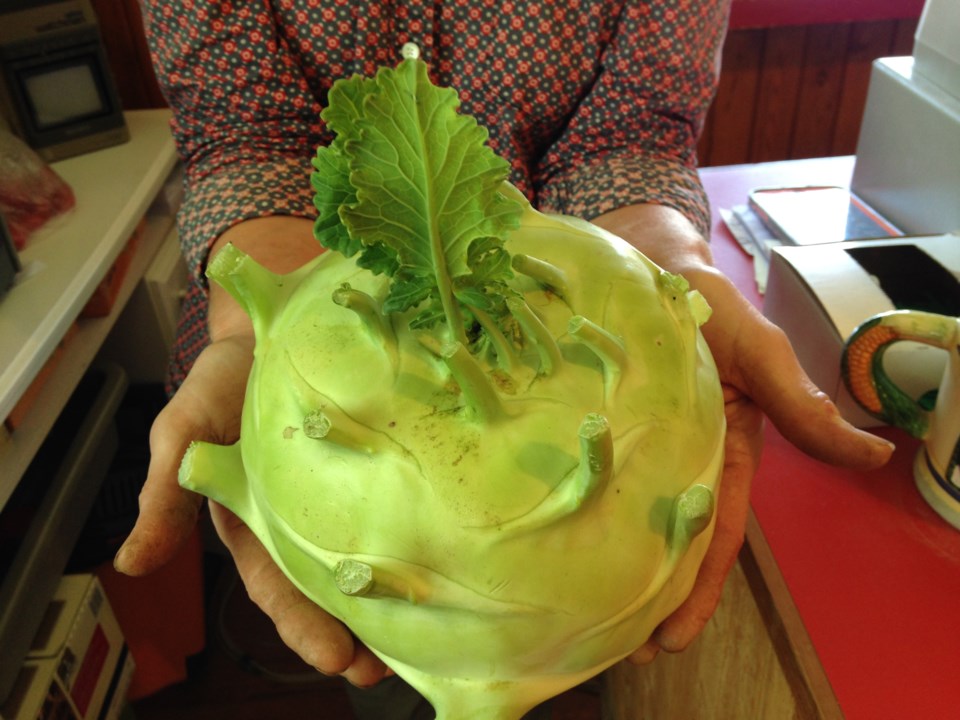If you have not had the opportunity to eat fresh kohlrabi, you are missing out. Kohlrabi (Brassica oleracea) is a member of the brassica family. Other members of the brassica family include cabbage, broccoli, Brussels sprouts, kale, cauliflower, turnips and radishes. Unlike these other cabbage family members, kohlrabi does not have many of the insect and disease issues that these other crops experience. Brassica vegetables are one of the crops that are ideally suited for growing in a northern climate: they are classified as cool-season vegetables.
Kohlrabi comes from the German word, ‘kohl’ meaning cabbage and ‘rabi’ meaning turnip. The earliest record of growing kohlrabi is from northern Europe approximately 500 years ago. Kohlrabi is sometimes referred to as ‘stem turnip’ since the main edible part is the above-ground swollen stem. Kohlrabi flesh is crisp and the flavour is sweeter than cabbage. Plants are either light green or purple in color. Interior flesh is white.
All young brassica seedlings can withstand a couple of degrees of frost. For this reason, kohlrabi can be direct seeded as early as the beginning of May. Plant seeds approximately 1cm deep and about 2.5cm apart. Spacing between rows should be 30-45cm. Seedlings should emerge within one week.
Flea beetles are one of the earliest pests of all brassica plants and kohlrabi is no exception. Flea beetles are tiny black flies (approximately 2mm in length) that jump from plant to plant and feed on leaves, giving a shot-hole appearance to stems and leaves. They are especially devastating to young seedlings by completely devouring tiny cotyledons and the first true leaves as they emerge. If flea beetles are a problem, cover new seedlings with thin crop covers for protection. Alternatively, kohlrabi can be transplanted: four- to six-week-old kohlrabi transplants are much more resistant to flea beetle damage than tiny emerging seedlings.
To grow kohlrabi transplants, seed plants indoors approximately six weeks before transplanting out (April 1 for planting out around May 15). Sow seeds in a commercial soilless media containing peatmoss, perlite and vermiculite. Soilless media provides a disease-free environment as well as excellent drainage to minimize root disease problems. Use flats, pots or containers with bottom drainage holes. At a soil or media temperature of 24 C, kohlrabi seeds will germinate in five or six days.
Kohlrabi seedling transplants require a minimum of 14 hours of light each day. Supplemental grow lights will probably be necessary to produce healthy, sturdy transplants. To test if you have sufficient lighting: the shadow cast on a white piece of paper at midday by an object 10 cm above a white piece of paper should have a definite outline. If there is no outline, light is inadequate and plants will stretch toward the light, becoming leggy. Contact your local garden center for appropriate grow lights. Place lights 30-45 cm above the seedlings for 12-14 hours during the day to provide adequate light. Fertilize developing transplants two times/week using 20-20-20 soluble fertilizer. Mix according to label directions.
A common fungal disease that can infect developing brassica transplants is ‘Damping off’. Symptoms of ‘Damping off’ include water-soaked stems that become constricted at the soil level. Plants wilt and eventually collapse. To prevent damping off, provide adequate air movement and light, avoid overwatering and crowding in young seedlings and transplants.
Kohlrabi transplants can be transplanted outdoors as soon as daytime temperatures reach 15 C and night temperatures are not below -2°C for several nights in a row. Harden off transplants before planting out by moving them outdoors into a sheltered, frost-free location at least 3 days before transplanting.
Mature kohlrabi plants range in height from 25-40cm tall. Kohlrabi is ready to harvest when the swollen above-ground stem reaches at least 7-8cm (late July - early August). Early in the harvest season, harvest alternate plants within the row to allow space for remaining roots to expand. Trim off the leaves close to the stem. The above-ground stem is the edible portion of the plant. The outer layer of the stem can be woody and tough. Peel these tough layers to expose soft, delicious flesh. Kohlrabi can be eaten raw or steamed. Oversize kohlrabi (15cm or more in diameter) may tend to have a dry and woody texture.
Kohlrabi cultivars recommended for northern growing include: ‘Kossak’ (very large stem but good texture), ‘Purple Vienna’, and ‘White Vienna’.
Jill Thomson is a retired Plant Pathologist who lives in Saskatoon, where she enjoys gardening with her family, including the dogs.
This column is provided courtesy of the Saskatchewan Perennial Society (SPS; saskperennial@hotmail.com ). Check our website (www.saskperennial.ca) or Facebook page (www.facebook.com/saskperennial) for a list of upcoming gardening events




